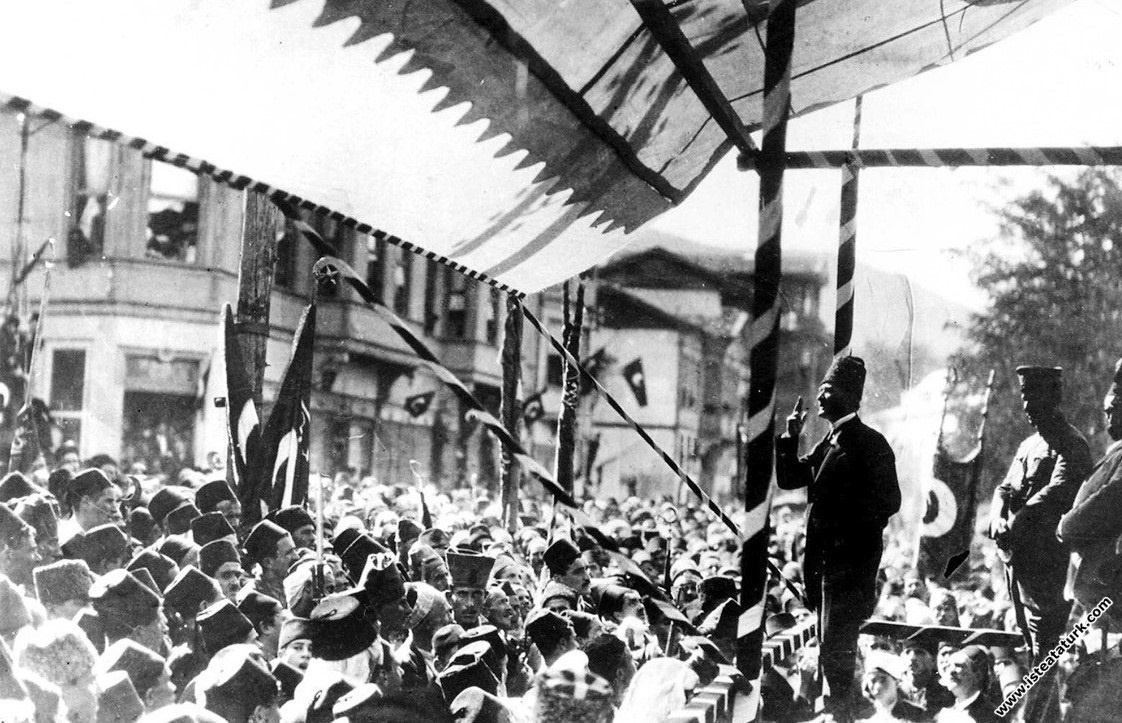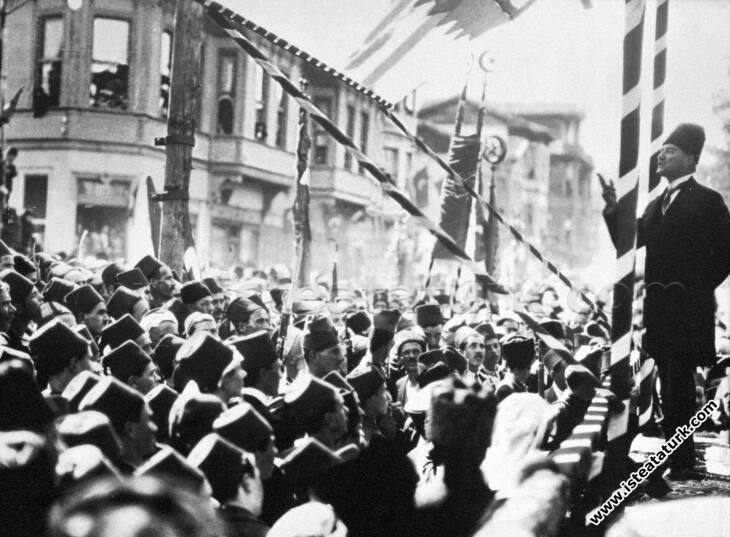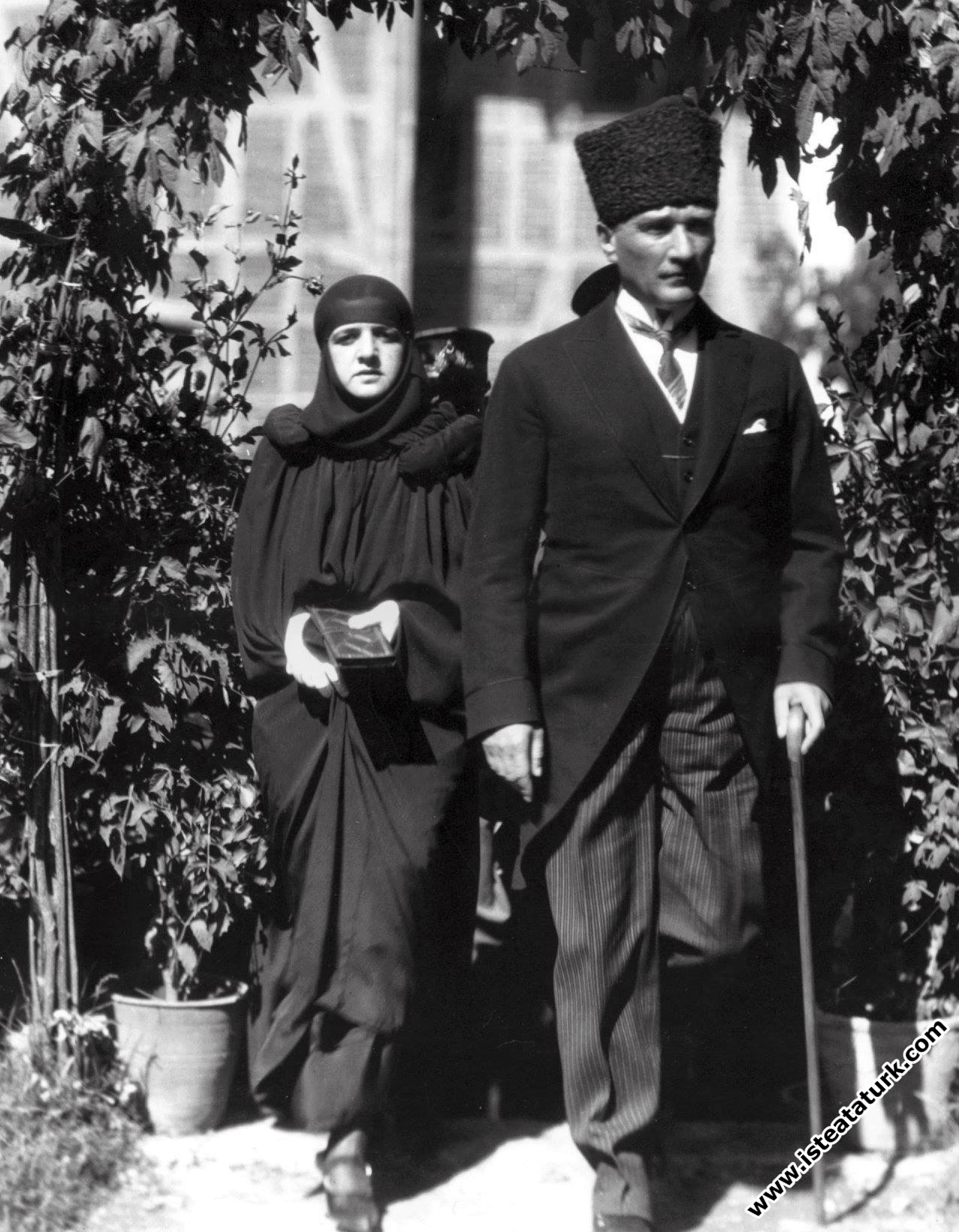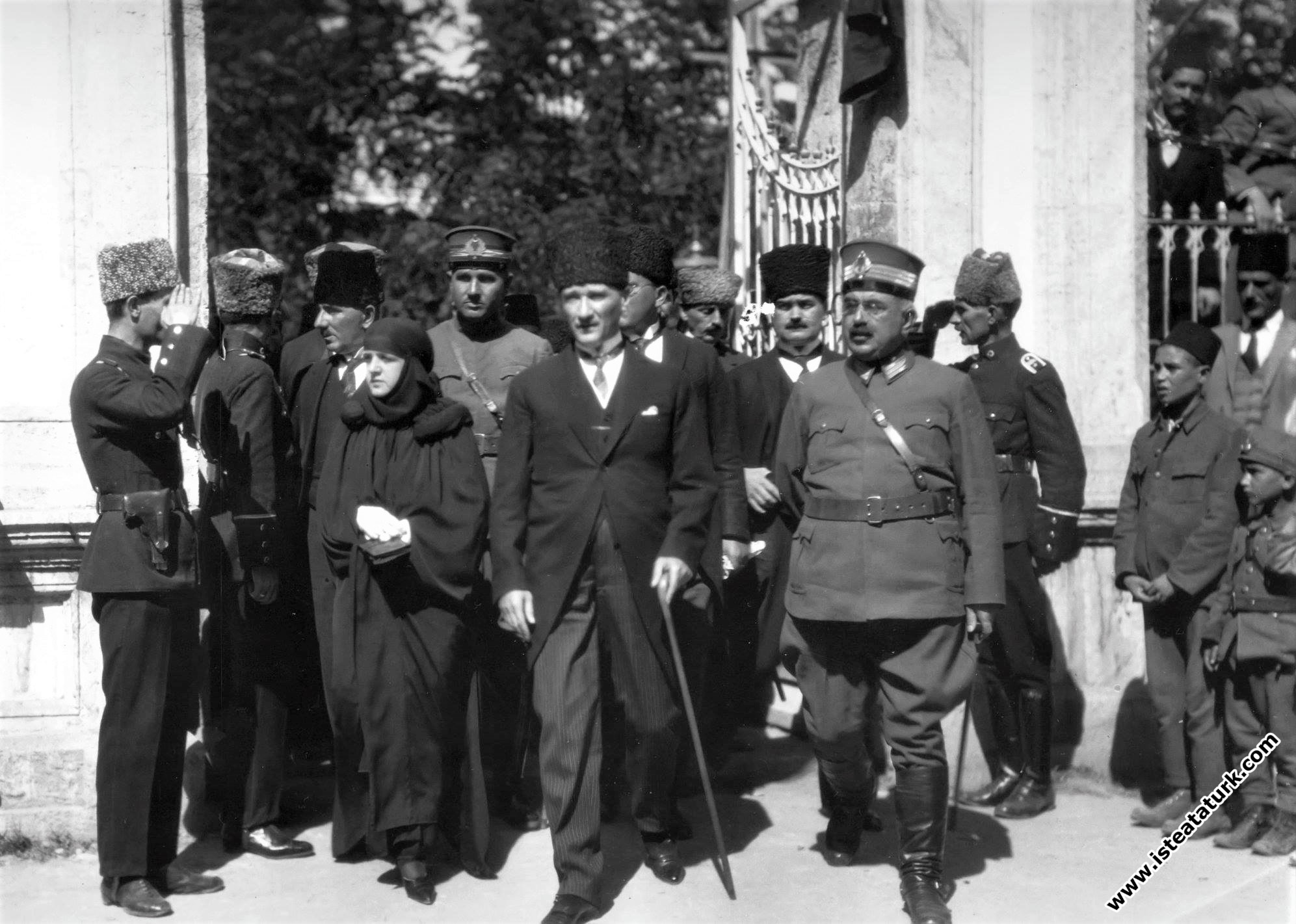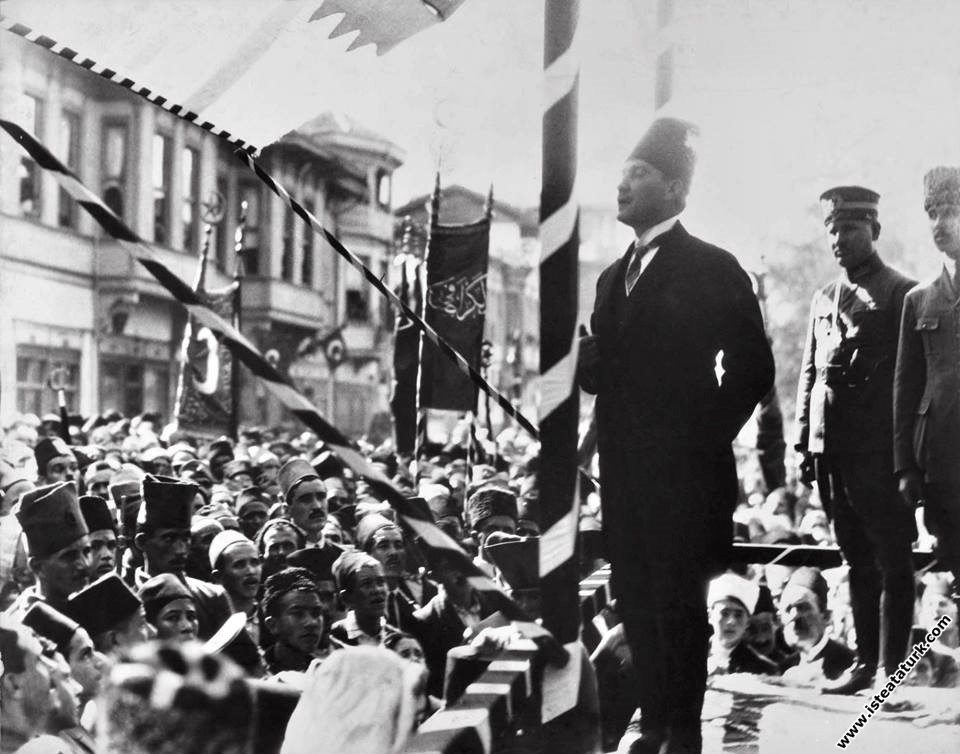Mustafa Kemal Atatürk hitting the first digging that started Samsun Çarşamba Railway Construction. (21.09.1924)
| Photo source: Mustafa Kemal Atatürk hitting the first digging that started Samsun Çarşamba Railway Construction. (21 September 1924) |
Mustafa Kemal Atatürk Samsun Çarşamba Demiryolu İnşaatı'nı başlatan ilk kazmayı vururken. (21 Eylül 1924)
The Groundbreaking Ceremony of the Samsun Railway and the Samsun Trip of the President Gazi Mustafa Pasha
The importance given to railway construction in the first years of the establishment of the Republic of Turkey is known. So; railways were described by Atatürk, the founder of the Turkish Republic, as “a sacred torch that illuminates a country with the lights of civilization and prosperity” 1 ; The duplication of railways for national purposes constituted the most important element of the general road policy .. An important railway network was created in a short period of time with the purchase of railways owned by foreign enterprises and the construction of governments and domestic capital; This issue, which the Turkish nation, which had fought for life and death in the Turkish War of Independence, under the leadership of Mustafa Kemal Pasha, regarded as a "national pride" and "praise" in the Republican era; It was engraved in the 10th Anniversary Anthem of the founding of the Republic, which the whole nation sang with great enthusiasm, with the line "We have knitted the motherland with iron nets from four basses". With the establishment of the Republic, the reason for giving such importance to railway construction in this new phase that opened before the Turkish people; It is the need for railways in the thought, desire and effort of being an economic state and being a civilized nation. This situation means that Turkey, which is in an effort to acquire a new identity, it has turned into a "national cause" in the direction of new goals. A developed country within national borders, a flourishing homeland, a strong state; the desire to create a bright-minded, prosperous people made up of strong individuals; In this new period, this has been the general aim of the new state.
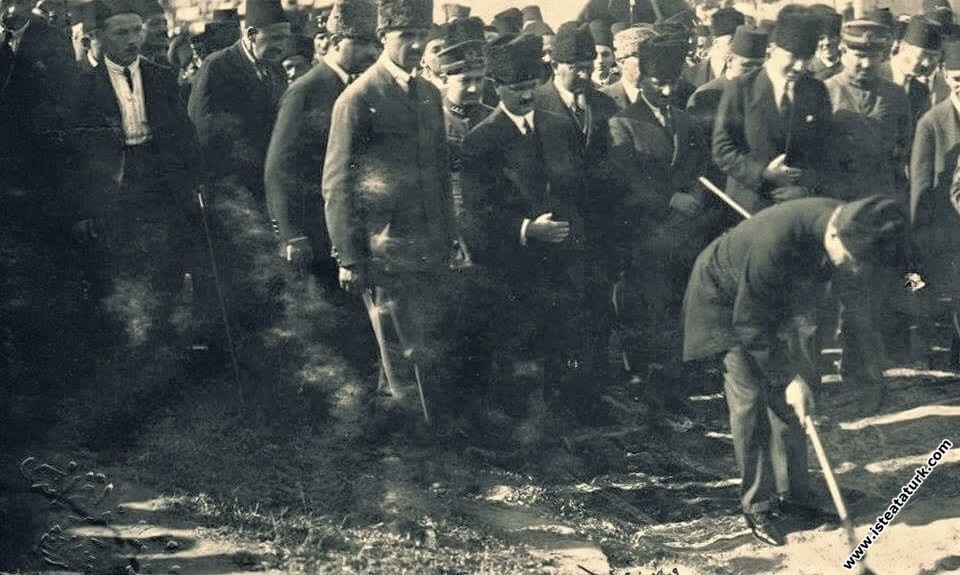
If the country was to be an economic country, there was a need for robust, efficient and high-capacity roads that would connect village to town, town to city, and cities to major export and import centers. However, the policies pursued by the Ottoman Empire for centuries did not bring much to Anatolia. Therefore, there seemed to be no roads suitable for transportation in Anatolia. Atatürk: "Couldn't it be possible to build seven hundred kilometers of roads in seven hundred years in our present provinces, which were liva yesterday?... Couldn't it be possible to build one kilometer road a year?" by asking; He was questioning the Ottoman Empire about the general corruption problem in Anatolia, about what it did not do before history, when it could have done 3 .
Until then, Anatolian Turks paid taxes and went to the army . Until the beginning of the 20th century, Turkish society could not even gain the identity of being an agricultural society, let alone an industrial society .. There was a closed society structure, a self-sufficient agricultural production. To get rid of the closed economy; It was necessary to produce more products than could be used, to go to the market, to buy and sell goods. This was possible with easy and cheap transportation. However, Turkish peasants were not able to acquire the habits and opportunities to do these things. Turkish peasants cannot grow many crops due to various impossibilities; If it grows, it cannot be brought to the market; If he did, he wouldn't be able to pay for the hardships that were worth the goods he sold. The product is of poor quality, the rate is low, the means of production are insufficient; road network was poor. The difficulty in transporting the crop sown with ox and slash and produced by the manual labor of the villagers to the wharves and large settlements was beyond what could be imagined. Transport was expensive, and prices were high in urban markets. Because of the lack of roads, For the warriors of the republican ideal, humiliating situations arose. Flour was brought from America, Romania, Bulgaria and the Soviet Union for the food supply of Istanbul, Izmir and the cities on the Black Sea coast; however, in areas with surplus grain such as Harput, Malatya and Konya, the wheat that cannot be transported to the places it needs is 'wasted'; While the wheat, which was tried to be hidden under the ground, rotted away, there was hunger in the coastal cities.6 . There were also many flour mills and mills in the coastal cities; However, due to the lack of roads and the inadequacy and primitiveness of transportation vehicles, wheat could not be brought here, and these mills and factories were not functioning. In the face of this situation, flour was brought by sea from America 7 . Most of the highways connecting Central Anatolia to other regions were in the form of paths. Railways are insufficient; The current ones were also low-capacity and in need of repair. In 1923, Konya Deputy Hacı Bekir Efendi said the following during the discussion of the subsistence problem in coastal cities in the Grand National Assembly of Turkey:“I am a man who has been involved in the wheat trade for thirty years. I am one of those who export a large amount of grain to Istanbul every year. Although there was a crop in Anatolia when there was a large amount of grain, I never saw that Istanbul was full when wheat was transported to Istanbul by current harvest... Istanbul always needs the flours and wheats of Bulgaria, Romania, America” 8 .
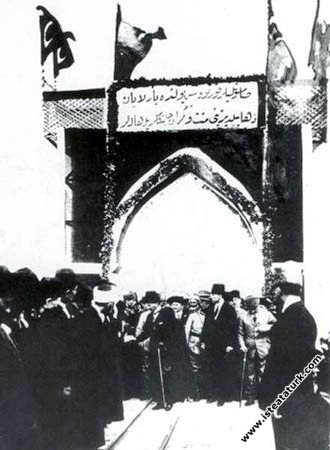
The people greet the Great Leader who came to Samsun on the cruiser Hamidiye. (September 20, 1924)
In 1923, while the price of wheat in coastal cities was 14-15 kuruş, it was 7-8 kuruş in Ankara 9 . The only reason for this contradictory situation was the inadequacy of roads and means of transport. For example, the cost of bringing a sack of flour to Istanbul by ship from the United States was almost twice less than the cost of transporting a sack of flour that can only be transported from Çorum or Merzifon to Samsun by roadways and by horse carts or oxcarts 10 .
In this case, what needed to be done was to build roads, ports and railroads in order to increase production and gain a place in world markets. Aware of this, the Kemalist cadre approached the problem with an interest that had never been seen before” and in 1924 gave a rather high appropriation of 16 million liras to the Ministry of Public Works12 . 10 million liras of this money was to be used for railway construction, and 3 million liras for the purchase of railroad ferries; whereas, in 1923, the entire budget of the Ministry of Public Works was only 2,110,000 TL13 .
Indeed, railways were the most effective investments to break the chain of poverty. With the existing coal basins and the modern coal enterprises to be established in Turkey, the solution of the transportation problem was being considered without being dependent on foreign sources. Although the old administrations also showed more or less interest in the railways; but, at that time, foreign capital undertook the construction and management of the existing railways; foreigners had taken almost complete control of the railways, with all kinds of privileges and guarantees. The country's underground and surface wealth was transferred to western countries for raw material needs .. However, it was obvious that the Kemalists, who had seen and experienced the results of the bitter experiences of the past, pursued "national" policies in order to break the chain of poverty and backwardness that surrounded Turkish society like the arms of a giant octopus. In these national policies, domestic capital should also do its part; moreover, the element of abstention and discouragement that was effective in some big projects had to be broken. Here, the first and most effective example in building national railways and breaking such negative factors in domestic capital was the construction of Samsun-Çeşamba Railway. Moreover, this railway, besides these features, was honored by the founder of the Republic of Turkey, the immortal leader Atatürk, for laying the foundation and for some good evaluations he made.
Samsun, the city where Mustafa Kemal Pasha set foot on May 19, 1919 and lit the fire of freedom and independence, has played an important role in the socio-economic, cultural formation and formation of the entire Black Sea coastline throughout history. Due to its geographical location, Samsun was connecting the Black Sea cities to Central Anatolia and other parts of Anatolia, except for sea transportation, due to the mountains extending parallel to the sea. The mountains that cut the connection of the Central and Eastern Black Sea cities were only passing through Samsun. Therefore, this city; in road and rail transport, it was like a permanent helmet to transfer the economic potential of the long coastline to other regions. Therefore, in the projects drawn in railway and highway construction, the way to the Black Sea was passing through Samsun. Considering this situation, the construction of the Samsun-Sivas railway was started and the foundation of this railway was laid on 9 November 1923. The construction of this road, which was given great importance by the republican governments, was continuing rapidly. But, another problem was this: Samsun-Sivas railway would connect Samsun to Central Anatolia and from there to other parts of the country; But, what road network could connect the Black Sea cities, towns and villages, which were stuck on the shore at the bottom of the inaccessible mountains, with this railway?
The state of the highways was, in a word, "devastated". There were highways to connect Samsun to the Eastern Black Sea; however, in many places these paved roads were frequently deteriorated, and at times they were buried under mud and gravel. Small settlements could only be reached by footpaths. The road between Samsun and Çarşamba was the main road. Many large and small rivers and streams, especially the Mert River, overflowed on rainy days, and the roads were deteriorating. Wednesday Plain had great potential for cereals and horticultural crops. The same was true for the Bafra Plain. Money was requested from the government for the construction and repair of Samsun-Çeşamba and Samsun-Bafra highway roads; With the resources at hand, the Samsun-Çeşamba highway was started to be repaired without losing any time .. But this requested money could not be obtained; because the Ministry of Public Works had allocated funds only for the Samsun-Havza road. Thus, the renewal of these roads was left to the "benevolence" and "effort" of the special administration budgets. Forced by these means, 123.000 liras was put into the special accounting budget for the year 1924 to be used in the repair of the Çarşamba, Terme, Bafra, Alaçam roads; Of this money, 33,000 lira was reserved for Wednesday, 50,000 lira for Bafra, 20,000 lira for Terme and 20,000 lira for Alaçam roads. While the Ministry of Finance was expected to pay 42,000 liras of this amount, the 81,000 liras available were increased to 150,700 liras as a result of the efforts of Samsun Governor Fahri Bey; Under these conditions, a “feverish” work was initiated and the repair of the Samsun-Çeşamba road was undertaken by using the stones pulled from the Abdal River by boats.16 .
However, the results to be obtained from these efforts were not sufficient to strengthen the economy of both Çarşamba and beyond, and Bafra and beyond. It seemed that the solution to the problem could only be achieved by extending the Samsun-Sivas railway to these basins. It was of vital importance to extend the railway network to the important centers of the country as soon as possible. Turkey, which has the desire and aspiration to create a national economy and national capital, can take a step towards realizing its longing to do great things in the future, by producing an exemplary work in an important engineering and construction branch such as railway construction, with the financing of domestic resources, that is, domestic capital. it would be easier. This longing and desire came true with the construction of the Samsun-Çeşamba railway, the foundation of which was laid in 1924. Thus, this railroad
_%201%20(2).jpg)
In the ceremony of starting the construction of Samsun - Çarşamba Railway. (21 September 1924)
In 1924, Nemlizadeler, one of the well-known industrialists of Samsun, won the construction concession of the railway, which was planned to be built on the Samsun-Çeşamba-Bafra line. According to the conditions of the concession, the railway line would extend from Samsun to Çarşamba and Terme from one end and from Bafra and Alaçam from the other end. The line width was 75 cm according to the standard dimensions. The construction of the Samsun-Wednesday section was to be done by the company that received the concession. For the other parts, “Hak-ı Miyar” is given for three years after the contract date. As Aziz Sami, the editor-in-chief of the news newspaper, stated, Samsun was thus “destined to become the center of the important railway network” 18.. Under these conditions, work began with a large engineering staff for the preliminary studies; However, the construction foundation of the railway could only be laid on September 21, 1924, by the President, Gazi Mustafa Kemal.
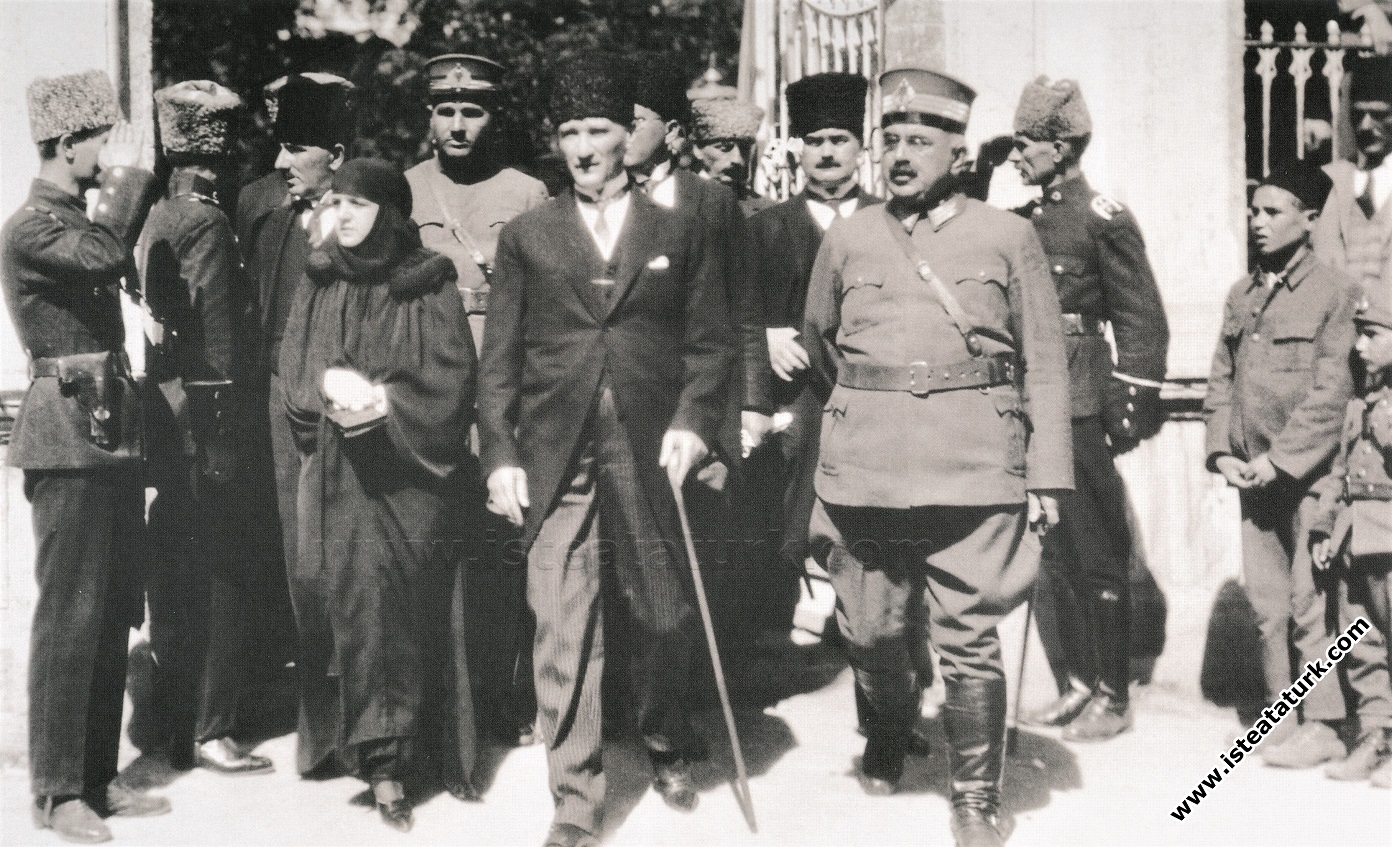
He is in Samsun with his wife Latife Hanım and General Ali Hikmet Ayerdem. (21 September 1924)
The President, Gazi Mustafa Kemal Pasha, went on a tour that would include the Eastern and Central Black Sea cities, as per the predetermined travel plan. He came to Bursa on 31 August, 10 September 1924, to attend the celebrations of the second anniversary of the liberation of Bursa; On September 11, 1924, he passed from Bursa to Mudanya. He boarded the cruiser Hamidiye in Mudanya and departed for Trabzon via Istanbul. Gazi, who came to Trabzon on September 15, 1924 and was welcomed with a great ceremony, stayed in this city for the first time until September 17, 192419. Gazi, who accepted the members of the city council, foreign consuls and members of the association in Trabzon, was considering going to Rize and then to Samsun for a trip. While still in Trabzon;
September 16, 1340
in Trabzon; On the Hamidiye Cruiser, To His Excellency The President, Gazi Pasha: The documents, such as the approval of the privilege as the first works of art, and the determination of the route and the arrangement of the maps of the Samsun-Wednesday-Bafra extension of the Samsun-Wednesday-Bafra extension, the preparation of the maps, were completed by the Ministry of Public Works. It has been certified by the -i language. Since we have learned, unfortunately, that his personal sâmî-i fehimane was on an honorable trip to the Black Sea coast at a time when the operation was delayed this week; We kindly request you to kindly request that the first operation of the work that has been created on the map by our company, whose foundations and committees are Turkish, will be carried out by their own sincere states, which will start on the ground from now on. The grace-u-celil states, which we are absolutely sure that Raikan will be commanded, will insult the memory of the Turkish nation by having a work actually started by the states party to the concession agreement, which we signed for the first time in the economic sheet of our republic, and will insult the Turkish nation with condolences and enthusiasm to the Turkish capitalists. It will be effort. Please accept our repentance arising from our sincerity, and we respectfully request and request you to order the time of the states of honor to send the people of Samsun to the people of Samsun and for the necessary intelligence, His Excellency the Pasha.
Nemlizade Mahdums
victorious
Mustafa Kemal Pasha, who received Galib Bey's telegram from the Nemlizades, replied to him as follows:
16 September 340
in Samsun; Nemlizade Prisoners to Galib Bey,
It is an extraordinary miracle for me to be in the first operation of the Samsun-Wednesday-Bafra extension simendifer line, which will begin on the ground. However, since it is not possible to determine our final settlement date to Samsun yet, I also request that the construction not be delayed due to this.
President
Ghazi Mustafa Kemal
This response 21 given by Mustafa Kemal Pasha to the telegram text 20 sent by Galib Bey is the best example of how meticulous and how excited he was in matters concerning the nation. Atatürk, who wanted the construction start date not to be delayed, as seen in this example, was a person with a "national feeling" who could never stand the delay of projects aimed at the national ideal.
Gazi's request was complied with. The official groundbreaking ceremony was postponed to the day of His coming; However, the works that can be done on the route where the railway will pass have continued. Thus, the honor of initiating the construction of this work, which will be a symbol of pleasure, praise and courage for the national capital, was earned with the laying of the foundation by Atatürk. Gazi, on the other hand, traveled to Rize, Giresun and Ordu until 20 September; He was able to reach Samsun on 20 September 22 .
On that day, Samsun and the people of Samsun, according to what Haber newspaper wrote; “They lived a great, historical day, the memory of which will remain forever in the hearts. Five years ago, when the clouds of cruelty and captivity were swirling over it, the country that welcomed its cherished guest with the sadness of those days; shaken with feelings of joy and longing” 23. Atatürk's arrival in Samsun; It was his first visit after May 19, 1919. The Hamidiye Cruiser carrying Gazi entered Samsun harbor at half past one on 20 September 1924. The people of Samsun, who filled the streets and avenues like crowds of apocalypse, were flowing towards the coast with their patience overflowing to see Gazi as soon as possible. The people did not comply with the welcoming program that the Tartib Committee had prepared in advance. Gazi was going to set foot in Samsun city from Tophane Pier. The plaque on a large arch decorated with oak and laurel leaves, prepared here, had the following inscription: “The people of Samsun; The Star of Genius Shining on the Road to Liberation, Gratitude and Thanksgiving Haloes” 24 .
While the Hamidiye Cruiser was floating in the still waters of the sea, the governor of Samsun, Fahri Bey, and the division commander, Gazi, departed from the pier to meet on board. Government officials, deputies and property groups, science and science committees, traders, city notables, members of the press, bar association committee, members of training centers, representatives of foreign organizations, tradesmen's organizations; They had formed a neat line starting from the pier set up on the pier. Salute balls thrown from the ship excited the greeters even more. As the motorboat that Gazi got off the Hamidiye Cruiser was approaching to the pier, a deep silence enveloped the whole environment. Gazi set foot on Samsun lands for the first time after 19 May 1919, at Tophane Pier. Sacrifices were sacrificed at the spot where He set foot. In the words of the news newspaper;25. As Gazi was approaching the Taka, masses of men and women, children and young people, and the elderly began to flock to the beach. In front of him, he shook the hands of those who greeted him one by one. Gazi was accompanied by his wife, Latife Hanım. He approached and checked the ceremony soldiers with his wife. He mingled with the people until Istiklal Trade School was passed. Upon the increase in the stampede created by the people, cars were compulsorily boarded. The people were watching Gazi in an enthusiastic crowd. Passing by greeting the people from Saathane Square, Gazi entered the municipality square via Küçük Sokak. The square was packed with school students, soldiers, and the public. The following was written on an arch built near the town hall: “O Victory Nuru, Great Veteran - Everywhere You Step Today; It trembles with the inspiration you gave us five years ago”26 .
While the Municipality Committee, the Teachers' Committee and other groups saluted Gazi, who got out of the car; Two female students from the girls' school made a short and exciting speech and gave a bouquet to Gazi and Latife Hanım. The girls' school students, who formed a cordon on the marble staircase in the municipality building, greeted Gazi and his wife one by one. Gazi took a short rest in the presidential room. Afterwards, the Governor welcomed the delegations presented to him by Fahri Bey. Meanwhile, the intense cheering of the people of Samsun, who were crowding in front of the city hall, resonated even inside the building. Thereupon, Gazi went up to the balcony of the building and greeted the people . At half past three, Gazi got into his car amid the flood of applause and moved with his wife to the mansion of Şahinzade Remzi Bey, who had left and prepared for him.28 .
In the evening, lantern regiments paraded through the city. He attended the dinner given in his honor by Gazi Samsun Municipality. Towards the end of the meal, Mayor İbrahim Veysi made a speech. Responding to İbrahim Veysi's speech by thanking him, Gazi stated that the title of the delegation, which is responsible for the administration of the dormitory, which spread to the whole nation in terms of ideal and purpose, is the People's Party, the "Republican Party", and that it is the only and certain way to take the country to the "area of peace and happiness". . Thereupon, the Mayor stood up and showed a seat behind Atatürk and said: “This seat is the seat of the President of the Republic, when they first came to Samsun, in the municipality office. Teberriiken was brought here,” he said. Gazi, who was extremely touched by this beautiful reminder, mentioned that his memories were refreshed and said, He gave a speech including the following sentences: “This precious country, this self-sacrificing people with pure consciousness; Although it has not been represented to the extent it deserves from time to time; I never hesitated to imagine Samsun and the people of Samsun as I first saw it and see it again today.29 .
Gazi attended the groundbreaking ceremony of the Samsun-Çeşamba Railway, which was built by Turkey for the first time with domestic capital, on September 21, 1924, on its second day in Samsun. The day before, an elegant arch was prepared in the ceremony area, and shades were made at intervals. The whole perimeter was adorned with cleaned laurel leaves and flags 30 . After Gazi, who came to the ceremony area with state officials, took his place, the ceremony started. Nemlizade Galib Bey, the concessionaire of the railway line, came to the podium and gave a speech. His speech was as follows:
“His Excellency the President!
We are allowed to see a new result of your great war, which opened a new era in our history. Of course, this blessing, this peace of happiness confers a different privilege with your state. More precisely, your faithfulness and effort; Your economic ideas make one with your fertile cooperation. Our attempt is a small introduction for now; but in fact, the existing spiritual values grant him a broad horizon of development. Now, you, the Samsun-Wednesday Railway, on which you will perform the principle, is not only a vain attempt, it is a symbol of eternal Turkish domination in our country, a completely national work of Turkish economy, a free sample of Turkish connoisseurs' foreign aid. i is wisdom.
If you; If you had not been a patriot, we Nemlizade prisoners could not have been entrepreneurs of this path. Had it not been for the cooperation of our republican government that you established, our efforts and ambitions would not have come true so soon, and today's ceremony would not have been successful. Finally, His Excellency the President, if there was no security and connection among the people, there would have been no encouragement and participation in our initiative from almost every point of our country from all over the province.
The foundation of the first part of this road, for which you signed the concession for the first time after your transition to the presidency of the nation, with its honorable and valuable merits, is also the basis of you, my dear veteran; It has been tasyib and muyesser to your zât-ı fehamet-semat. We declare that we will be proud of this forever, and we contemplate your will-i-state based on the basis of the law” 31 .
After Galib Bey's speech, President Ghazi Mustafa Kemal Pasha said the following in his speech:
“Sirs,
The attempt of our citizens to build a railway in the country with a national capital is extremely important from many points that do not need explanation. It can be easily guessed how much satisfaction and admiration such national initiatives have been received by our Government and the leadership. The opportunity to personally see that the first national enterprise in railroad construction has been started is a happy coincidence for me. Considering that our country has been corrupt for centuries and the need for a railroad is considered, it is perfectly understandable how much it would be necessary to appreciate the entrepreneurs in this matter and to what extent it would be helpful to them. I warmly congratulate the Nemlioğulları for this attempt and success.
.jpg)
Mustafa Kemal Atatürk addressing the public at the ceremony that started the Samsun Çarşamba Railway Construction. (21.09.1924)
Gentlemen, as in all parts of the country, in our provinces that I visited this time, it was bitterly repeated by all the people of the nation that the biggest problem was corruption. Participation in this prayer is natural. With deepest regret, I asked those concerned that the road to the province is sufficient, how many kilometers of roads are needed to be built. The stated figures were two hundred, three hundred, four hundred kilometers. I thought about these numbers after I had reached five hundred or even seven hundred kilometers for the provinces I saw; Couldn't seven hundred kilometers of roads be built in seven hundred years in our present provinces, which were liva yesterday? Let me put it more simply; Wouldn't it be possible to make a one kilometer road in a year? The whole nation needs to make this calculation and think more deeply about the reasons for it every day. This calculation and consideration also serves to be fair about today's administrators. Gentlemen, in this connection, I should also declare that those who do not know what they want to do with the administration of the country, in addition, should be advised to apply to the common sense of the people. The people, the villagers everywhere warned me about the work schedule with these two words: Road, school. In fact, when they say that the road is the wing of the villager when they talk about the road, it is understood that they attach importance to it first of all. In fact, all economics is in the first word and everything is in the second word. Gentlemen, as the railway that will connect Samsun, the pier of central Anatolia, to Sivas was started, what a precious example was the actual endeavour of Nemlioğulları to the real program.32 .
When Gazi finished his speech, the groundbreaking ceremony began. Mustafa Kemal Pasha and then Governor Fahri Bey put the first mortar on the foundation with a silver pickaxe and shovel prepared in advance. While the ceremony was ended with the sacrifices cut along the railway; Gazi went to the government office with his “maiyet-i staff” 33 .
Thus, the foundation of the railway, which was started to be built for the first time with national capital in Turkey, was laid by the hand of the President, Gazi Mustafa Kemal Pasha. This initiative, which is a source of honor for the new economic state, has also been an example of courage for Turkish entrepreneurs.
Gazi Mustafa Kemal Pasha stayed in Samsun for three more days. Gazi, who left the groundbreaking area by complimenting the officers, visited the Division Command, the Military Hospital, the Ayyıldız Sports Club and the Mıntıka Palas, where he established his headquarters and resided when he landed in Samsun five years ago, on May 19, 1919 . . Owners of Mıntıka Palas gifted this building full of good memories to Gazi35. Gazi was very impressed by this beautiful gift. This building was later turned into a museum exhibiting the items used by Gazi when he went to Samsun.
Gazi, who went to the mansion of Remzi Bey, where he resided, was impressed by a small group that passed by with loving cheers and singing the national anthems, and greeted this group by going to the window. Later, he went to the Istiklal Theater Building by car. This building was furnished very attractively by Ayyıldız Sports Club. Meanwhile, an unusual sight in Samsun took place in this building. In Haber's words; In the Turkish Theater Hall, Turkish women also performed “arz-ı vücûd” 36 .
On his third day in Samsun, Gazi Mustafa Kemal Pasha spent part of his day with those who visited him in the house where he was staying. Latife Hanım was also interested in women from Samsun who came in groups. In the evening, upon the invitation of the İstiklâl Ticaret Mektebi, she attended the tea feast given by the teachers in the school hall. Mustafa Kemal Pasha, in this meeting, the Kemalist thought system; in other words, he gave an important speech including the famous sentence used to explain the scientific aspect of Atatürkist Ideology: “Reverend lady, respected gentlemen. Special thanks to those who organized this tea feast. This occasion brought me to a very enlightened neighborhood of Samsun. This occasion made me very happy in the presence of a committee of precious people whose minds are adorned with knowledge and science.. For everything in the world,37 .
The next day (23 September 1924), President Gazi Mustafa Kemal Pasha accepted the visits of the Drama and Kavala immigrants settled in Samsun, received information about their situation, learned their needs and listened to their wishes. His wife, Latife Hanım, also paid a visit to the women from Samsun38. Gazi also held a meeting with the relevant people in the municipality and got information about the problems and needs of the city. He spent the rest of his time reading the history books he had brought from the Samsun Library .. On the same day, in the house of Şahinzade Remzi Bey, where he 'resided' during his stay in Samsun, he wrote the following sentences as a memento in his family album: “We were honored by the hospitality and kindness of the owner of Şahinzade Remzi Bey, whom we were guests during the days I stayed in Samsun. I will save it as a copy” 40 .
At the end of his four days in Samsun, President Gazi Mustafa Kemal Pasha; On Wednesday, September 24, 1924, at 9 a.m., he left Samsun to go to Erzurum. 4 1. Haber newspaper, in an article saying goodbye to Gazi, said: You commanded our future path to light and well-being with the light of your genius in the four days when it was blessed, productive and happy. In ecstasy and excitement, your lofty addresses, which you abhor our hearts, will be our guide in the way of exchange and understanding of your principles of harmony” 42 .
In these four days, the great leader who deals with many socio-economic and cultural problems of the city; He laid the foundation of Samsun-Çeşamba Railway, which was built with national capital for the first time in Turkey, on September 21, 1924. The need for a road in the midst of the deep-rooted problems the country was in at that time; He played a key role in solving many problems. Its length is 45 km. Samsun-Çeşamba Railway, which is the main railway station, was largely completed at the end of 1925; however, due to the indifference of transportation policies that focused on highways after the 1950s, it gradually lost its old function; As a result, in the 1980s, this railway was re-handled and the road was renewed. It is known what the positive function of railways is in the development moves of the Republic of Turkey in economic fields. In this aspect too, The positive contributions of the Samsun-Çeşamba Railway cannot be underestimated. As mentioned above, this work, which will be the symbol of the 'national resurrection' in terms of economy and will play a major role in strengthening the sense of 'self-confidence' for Turkish entrepreneurs in order to produce many other and greater works; It has the honor of placing the first mortar on its foundation by Mustafa Kemal Atatürk, who saved the Turks from the brink of extinction at the beginning of the 20th century.
1 Atatürk’ün, TBMM’nin V. dönem, III. toplanma yılını açış konuşmasından; bk: Atatürk’ün Söylev ve Demeçleri, C.I, Ankara, 1961, s.416.
2 Cumhuriyet döneminde limanların, demiryollarının ve karayollarının birlikte ele alınarak, yurdun en ücra köşelerini büyük kentlere ve limanlara bağlanması gereğine değinen plânlama için bk: Umur-u Nafıa Programı, İstanbul, 1923; yine bk: Ziya Gürel, Kurtuluş Savaşı’nda Demiryolculuk, TTK yay., Ankara, 1989.
3 Atatürk’ün Söylev ve Demeçleri, C.II, Ankara, 1981,5.193.
4 a.g.e., s.121.
5 Başlıca şu eserlere bk: Yahya S. Tezel, Cumhuriyet Döneminin iktisadi Tarihi (1923-1950), Yurt Yayınlan: 4, Ankara, 1982; Çağlar Keyder, Dünya Ekonomisi İçinde Türkiye (1923-1929), Yurt Yayınlan: 3, Ankara, 1982; yine bk: Tevfık Çavdar, Milli Mücadele Başlarken Sayılarla Vaziyet ve Manzarai Umumiye, İstanbul, 1971.
6 Aziz Sami, “Yollarımız”, Haber, (Samsun’da çıkan haftalık gazete), 14 Şubat 1924.
7 Türk deniz ticaret filosunun kuruluşu, Osmanlı Devleti, Türk Kurtuluş Savaşı ve Cumhuriyetin ilk yıllarında nicelik ve nitelik yönlerden karşılaştırmalı durumu için bk: “Türk Ticaret-i Bahriyesi”, Ayın Tarihi, II/6, ss.617-622.
8 TBMM Zabıt Ceridesi, I, 3, C. XXVI, Ankara, 1960, s.242.
9 a.g.e., s.243.
10 Haber, aynı sayı; “ Üretilen çözüm yollarının genel niteliğinin, her yönden ulusal çıkarlara uygunluğu ve ulusal ekonomi ilkesiyle paralellik taşıdığı dikkat çeker."
12 TBMM Zabıt Ceridesi, II, I, C. VI, Ankara, 1968, s. 169.
13 a.g.e., s.169; 1924 yılı bütçesinin genel harcama kalemi 128 milyon 900 bin lira; gelir kalemi ise, 120 milyon 400 bin liraydı; bk; a.g.e., s.166; bu rakamlara göre, 1924 yılında Nafia Vekâleti’ne verilen 16 milyon liranın ne derece büyük bir oran olduğu ortadadır.
14 Konu ile ilgili olarak başlıca şu eserlere bk: Orhan Kurmuş, Emperyalizmin Türkiye-ye Girift, 3. baskı, Ankara, 1982; İlber Ortaylı, II. Abdülhamit Döneminde Osmanlı İmparatorluğu’nda Alman Nüfuzu, Ankara, 1981; Lothar Rathman, Berün-Bağdat: Alman Emperyalizminin Türkiye’ye Girişi, (Haz: R. Zarakolu), 2. baskı, İstanbul, 1982; yine bk: Unsal Yavuz, “Askeri Strateji Açısından Türkiye’deki Demiryolları (1856-1923)”, Birinci Askeri Tarih Semineri, Bildiriler: II, Ankara, 1983, ss.179-187.
15 Haber, 13 Mart 1924.
16 Aziz Sami, “Yolların İnşaatı”, Haber, 3 Nisan 1924.
17 Haber, 27 Mart 1924.
18 Aziz Sami, aynı makale.
19 Reisicumhur Gazi Mustafa Kemal Paşa Hazretleri ‘nin Sonbahar Seyahatleri (1924), Ankara, 1925, ss.66-81; yine bk: Utkan Kocatürk, -Doğumundan Ölümüne Kadar- Kaynakçalı Atatürk Günlüğü, tş Bankası yay., t.y., ss.248-249; ayrıca bk: aynı yazar, Atatürk ve Türkiye Cumhuriyeti Tarihi Kronolojisi, TTK yay., Ankara, 1983, s.417; Mehmet Önder, Atatürk’ün Yurt Gezileri, İş Bankası yay., Ankara, 1975, s.296.
20 Haber, 18 Eylül 1924.
21 Haber, aynı sayı.
22 Utkan Kocatürk, Kaynakçalı Atatürk Günlüğü, s.250; aynı yazar, Atatürk ve Türkiye Cumhuriyeti Tarihi Kronolojisi, s.418.
23 Haber, 24 Eylül 1924.
24 Haber, aynı sayı.
25 Haber, aynı sayı.
26 Haber, aynı sayı.
27 Haber, aynı sayı; yine bk: Mehmet önder, a.g.e., s.303.
28 Haber, aynı sayı.
29 Konuşmanın tamamı için bk. Atatürk’ün Söylev ve Demeçleri, C.II, Ankara, 1981, ss. 190-192.
30 Haber, aynı sayı.
31 Haber, aynı sayı.
32 Haber, aynı sayı; tam metin için yine bk. Atatürk’ün Söylev ve Demeçleri, C.II, s.193-194.
33 Haber, aynı sayı; kısmen bk. Mehmet Önder, a.g.e., s.303.
34 Haber, aynı sayı.
35 Mehmet Önder, a.g.e., s.303.
36 Haber, aynı sayı.
37 Atatürk’ün Söylev ve Demeçleri, C. II, s. 194-199.
38 Haber, aynı sayı.
39 Mehmet önder, a.g.e., s.304.
40 Cemal Kutay, Bilinmeyen Tarihimiz, İstanbul, 1974, s.400; Mehmet Önder, a.g.e., s.304.
41 Utkan Kocatürk, Atatürk ve Türkiye Cumhuriyeti Tarihi Kronolojisi, s.420.
42 Gazi’yi uğurlama programı ve Samsun Belediyesi’nin Gazi’ye gösterilen sıcak ilgiden dolayı Samsun halkına teşekkürü: Haber, aynı sayı.
Research Assistant Kemal Arı
Source: ATATÜRK ARAŞTIRMA MERKEZİ DERGİSİ, Sayı 21, Cilt: VII, Temmuz 1991
